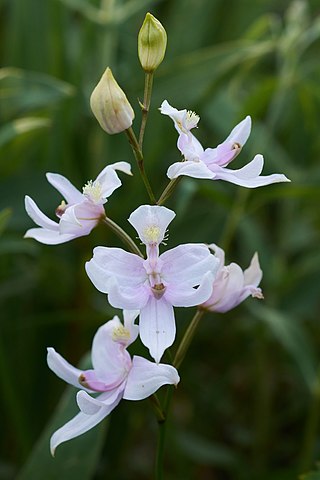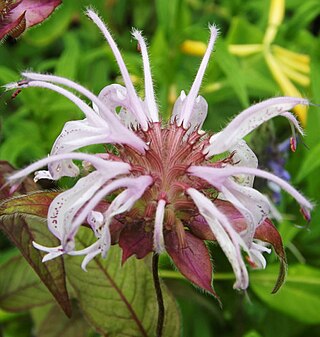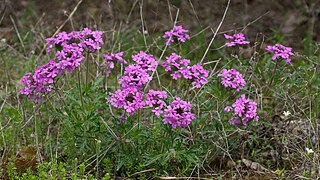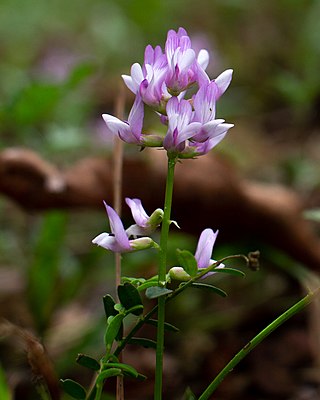
Monarda didyma, the crimson beebalm, scarlet beebalm, scarlet monarda, Eau-de-Cologne plant, Oswego tea, or bergamot, is an aromatic herb in the family Lamiaceae, native to eastern North America from Maine west to Ontario and Minnesota, and south to northern Georgia. Its odor is considered similar to that of the bergamot orange, which is used to flavor Earl Grey tea. The genus name comes from Nicolas Monardes, who described the first American flora in 1569.

Monarda is a genus of flowering plants in the mint family, Lamiaceae. The genus is endemic to North America. Common names include bergamot, bee balm, horsemint, and oswego tea, the first being inspired by the fragrance of the leaves, which is reminiscent of bergamot orange. The genus was named for the Spanish botanist Nicolás Monardes, who wrote a book in 1574 describing plants of the New World.

Calopogon oklahomensis, commonly known as the Oklahoma grass pink or prairie grass pink, is a terrestrial species of orchid native to the United States. It is restricted to the states of Alabama, Arkansas, Georgia, Illinois, Indiana, Iowa, Kansas, Louisiana, Minnesota, Mississippi, Missouri, Oklahoma, South Carolina, Tennessee, Texas, and Wisconsin. It is extirpated throughout most of its range. Calopogon oklahomensis is a perennial herb with flowers that are white, pink or purple, with a labellum with an apical region of yellow hairs. Flowers bloom March to July. Its habitats include coastal prairies, savannas, edges of bogs, and oak woodlands. It was described by Douglas H. Goldman in 1995.

Monarda citriodora is a species of flowering plant in the mint family, Lamiaceae, that is native to the southern United States and northern Mexico. Common names include lemon beebalm, lemon mint and purple horsemint. When crushed, the leaves emit an odor reminiscent of lemons. This odor is sometimes described as more resembling oregano, especially late in the season. Its purple flowers are highly attractive to butterflies, bees and hummingbirds.

Monarda fistulosa, the wild bergamot or bee balm, is a wildflower in the mint family Lamiaceae, widespread and abundant as a native plant in much of North America. This plant, with showy summer-blooming pink to lavender flowers, is often used as a honey plant, medicinal plant, and garden ornamental. The species is quite variable, and several subspecies or varieties have been recognized within it.

Rosa carolina, commonly known as the Carolina rose, pasture rose, or prairie rose, is a perennial shrub in the rose family native to eastern North America. It can be found in nearly all US states and Canadian provinces east of the Great Plains. It is common throughout its range and can be found in a wide variety of open habitats, from thickets and open woods to roadsides and along railroads.

Ratibida columnifera, commonly known as upright prairie coneflower, Mexican hat, and longhead prairie coneflower, is a perennial species of flowering plant in the genus Ratibida in the family Asteraceae. It is native to much of North America and inhabits prairies, plains, roadsides, and disturbed areas from southern Canada through most of the United States to northern Mexico.
Melicope makahae, the Makaha Valley melicope, is a species of plant in the family Rutaceae. It is a perennial shrub or tree that grows up to 10 ft (3.0 m) tall.

Amorpha fruticosa is a species of flowering plant in the legume family Fabaceae, known by several common names, including desert false indigo, false indigo-bush, and bastard indigobush. It is native to North America.

Blephilia ciliata is a species of herbaceous perennial plant in the Lamiaceae (mint) family native to central and eastern North America. It is commonly called downy wood mint. Other common names include downy pagoda-plant, sunny woodmint and Ohio horsemint.

Conoclinium coelestinum, commonly known as blue mistflower, mistflower, wild ageratum, or blue boneset, is a North American species of herbaceous perennial flowering plant in the family Asteraceae. It was formerly classified in the genus Eupatorium, but phylogenetic analyses in the late 20th century research indicated that that genus should be split, and the species was reclassified in Conoclinium.

Clethra acuminata, the mountain pepper bush, is a shrub native to the Appalachian Mountains of the southeastern United States. It has been reported from the states of Pennsylvania, West Virginia, Virginia, North Carolina, South Carolina, Georgia, Alabama and Tennessee, primarily from deciduous forests at elevations of 500–1,400 m (1,600–4,600 ft).

Monarda clinopodioides, common name basil beebalm, is a plant species native to Kansas, Oklahoma, Louisiana and Texas.

Monarda bradburiana, the eastern beebalm or Bradbury's beebalm, is a species of perennial flowering plant in the mint family, Lamiaceae, that is native to much of the southeastern United States.

Lespedeza repens, common names creeping lespedeza, creeping bush-clover, and trailing lespedeza, is a plant native to the eastern and central United States and northeastern Mexico. It is listed as a species of special concern in Connecticut and as rare in New York. It is a perennial herb which blooms May to September. Its habitats include open woods, clearings, and thickets.

Verbena canadensis, commonly known as rose mock vervain, rose verbena, clump verbena or rose vervain is a perennial herbaceous flowering plant in the verbena family (Verbenaceae) with showy pink to purple flowers.. It is native to the eastern and south-central areas of the United States. This species is widely cultivated as an ornamental, and naturalized populations have been established outside its native range, such as in the northeastern U.S.

Astragalus distortus is a species of flowering plant in the legume family known by the common name Ozark milkvetch. It is found in the central United States. Missouri has a wide distribution of this plant, but is uncommon or absent in the northwestern and southeastern sections of the state. The species is subdivided into two varieties, neither of which is particularly common. There is no vine on the plant in Missouri, and it has small, purple inflorescences. Identifying characteristics include its small size, non-vining habit, and its inflorescences. It is a perennial herb. Its habitats include prairies and savannas.

Euphorbia davidii, known as David's spurge or toothed spurge, is a species of flowering plant in the spurge family Euphorbiaceae. It is an annual herb growing up to 2 feet tall. Leaves are opposite in arrangement with narrow to broadly elliptic blades.
Monarda russeliana is a species of flowering plant in the mint family. It is commonly known as redpurple beebalm and Russell's beebalm.
Thelesperma nuecense, the Rio Grande greenthread, is an annual species of flowering plant in the aster family. It is native to Texas.

















